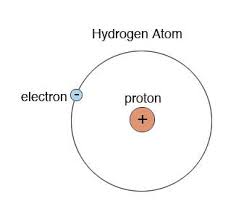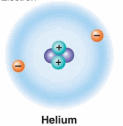(This is a continuation of the previous article)
When we look at “Data” as a human experience, it consists of many elements. For example, some data may be as simple as the hydrogen atom with just one proton in the nucleus and an electron revolving around it. The charge is neutral, the mass is very light.
 In comparison, a Helium atom is heavier with two protons and two neutrons in the nucleus with two electrons revolving around the nucleus.
In comparison, a Helium atom is heavier with two protons and two neutrons in the nucleus with two electrons revolving around the nucleus.
Though helium is heavier than Hydrogen, these are still lighter elements compared to the Uranuim or Lead.
Some elements when they combine with other elements become molecular compounds and exhibit properties different from that of the individual elements. When two gaseous elements like  Hydrogen and oxygen combine together they may together form a liquid called water. Some of the molecules may be so tightly bound that they even become solids.
Hydrogen and oxygen combine together they may together form a liquid called water. Some of the molecules may be so tightly bound that they even become solids.
Thus depending on the combination of protons and neutrons as well as the binding force that binds one atom with anther atom, elements take different form and different properties . Along with these properties they acquire different values.
Similarly, when we look at “Personal Data”, if there is only one element of data such as “Name” with a company, it is an “Unstable” atomic existence. If it is associated with some additional core element like the E-mail address, Mobile Number or a Social Security/Aadhaar/PAN number, the personal data acquires a complete atomic structure. If the number of electrons are not balanced with the number of protons, there could be an energy imbalance such as what happens when the data security is weak.
When more data parameters get associated with personal data, it gains an atomic mass. Name becomes an identifiable data. identifiable personal data becomes health data or finance data and so on. Similarly personal data may become sensitive personal data and critical personal data depending on what type of data elements are associated with the data set.
Further, when an atom is broken up and some elements are released, there can be a fission that may lead to formation of other compounds and also release of energy. If the energy release is controlled or moderated, then it may be used to the benefit of the society. But if the energy is released to the wild like a hacker who places the data on the web just to prove that he has the hacking capability, then it may be destructive like an atomic bomb. The Snowden’s release of data was perhaps one such uncontrolled fission of data.
Some times fusion of one data set with another data set creates a molecule. This could be an aggregation of data of multiple people creating a community data. If conditions are ripe, the fusion may result in nuclear fusion resulting in release of enormous amount of energy which if not regulated can be destructive. The Big data industry and the IoT is creating such situation where regulation is becoming essential to ensure that aggregation instead of creating useful molecules can release destructive energies like in the case of Cambridge Analytica.
By appropriately removing select data elements, some personal data can be rendered “Anonymized Personal data”. What distinguishes an anonymous data from an identifiable data is the absence of certain “Identity elements”.
While building a “Data Set” in an organization, it is necessary to identify what constitutes the “Nucleus” of the data and what constitutes the peripheral data elements which simply revolve around the nucleus. The parameter like the PAN number which in isolation can be used with publicly available data base can be considered as a key nucleic particle. Even the Name cannot be called a uniquely identifiable sub element of data since there could be many persons who may have the same name. E Mail address alone is not also an identifiable data element since in the present regime, e-mail address is allocated on first cum first served basis and is associated with a domain only.
In some of the data protection regulations, there is a tendency to identify certain elements such as IP address, Street Name, Postal PIN or Date of Birth as “Personal Data”. As a result companies get worried about such data coming into their control. But unless such data is combined with a “Core data element” these individual elements are like unbound electrons that are floating around meaninglessly. When these start revolving around the nucleus of the core identity element, they together acquire the characteristic of a complete “Atom” or “Meaningful personal data”.
Some times new elements of data come into the system and they get attached to different nucleic data. Then the property of the core data may undergo a metamorphosis either on its own or when combined into a molecule along with other data.
The molecular bonding between different atomic particles can be manipulated by companies to discover “New Molecules” . This fusion can create a completely different product with hitherto unknown benefits. Probably the algorithms created by business to add value to data aggregation is therefore like the “Chemical Molecules” created by a bio technology industry on which Product and Process patents are recognized.
Thus, looking at “Personal Data Set” as an “Atom with Protons, Neutrons and electrons” and their ability to be combined or divided as creating value of different kinds gives a new perspective to the way we look at Data and how it has to be protected and regulated.
Protecting an atom from dissipating requires creation of a bonding force and a balance of charge. This is what data protection professionals need to do. If an atom lacks the required bonding then with the slightest nudge from an outside element a chain reaction of fission can be triggered with damage alround.
The Security measures need to ensure that fission if any is within a controlled environment of a heavy water surrounding so that the chain reaction can be controlled and harnessed.
Data Governance professionals need to build such nuclear reactors that are capable of moderating the fission and fusion so that the energy created can be harnessed for the benefit of the society.
The upcoming Data Governance Act of India should therefore be like a design of a “Data Reactor” that helps in the creation of data aggregation for the benefit of the society and protection of data from a radiation leak.
…May be others can add further thought to this Nuclear Theory of Data.
Naavi







